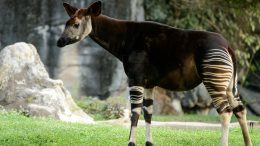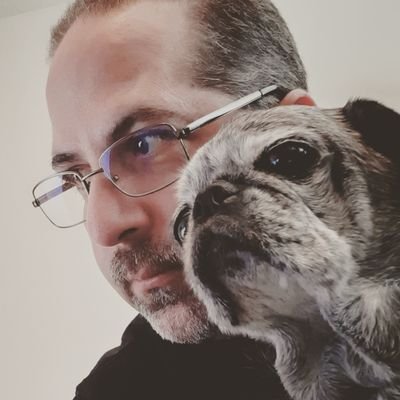Thirteen years after a bloody tragedy, an okapi has come to live in Epulu.
The village in the Democratic Republic of Congo is also the headquarters of a nonprofit called the Okapi Conservation Project, which was established to preserve its namesake species. The organization once cared for more than a dozen okapis there, who served as “ambassadors” to showcase how important it was to protect these rarely seen, zebra-like animals.
But a militia attack in 2012 killed all the resident okapis, as well as many of the people who had dedicated their lives to protecting them.
I reported on the murders when they happened and have been watching for updates ever since. This week Mongabay finally shared some good news:
In February 2025, rangers at Okapi Wildlife Reserve in the Democratic Republic of Congo, in partnership with the Okapi Conservation Project, successfully brought an okapi to Epulu, site of the reserve’s headquarters. It’s the first okapi there in more than 10 years… The endangered okapi was captured near the city of Bunia and is now under the watch of the reserve’s rangers as it roams freely in Epulu. Park visitors may be lucky enough to see it again a decade later, if security conditions permit, sources say.
My article on the attack, originally published in 2012 by Scientific American, is no longer online. To help preserve this history, we are now republishing it with a few annotations:
Okapi Conservation Center Recovering after Militia Attack
On Sunday June 24, 2012, an armed militia group opened fire on the headquarters of the Okapi Conservation Project near the village of Epulu in the Democratic Republic of Congo. By the time they receded into the forest two days later, six people and 13 of the 14 “ambassador” okapi who lived at the center were dead. Among those murdered were two rangers, a government immigration official, two villagers and the wife of a third ranger — a revenge-killing by poachers who had been arrested by her husband in the past.
The rebels — who were retaliating against antipoaching operations led by the OCP and the Institute in Congo for the Conservation of Nature — also burned buildings and looted supplies, doing tens of thousands of dollars’ worth of damage in the process. The 14th okapi died a few days after United Nations and Congolese Army forces arrived to retake the village.
Okapi (Okapia johnstoni) — horselike animals with zebralike stripes who are closely related to giraffes — are the national animal of the DRC, the only country in which they can be found. But the elusive, camouflaged animals are rarely if ever actually seen in the wild, and the 14 okapi penned in Epulu were the only ones in captivity in the country.
For most people in civil war–torn DRC, the only place to see a live okapi was at the OCP headquarters. The nongovernmental organization was founded to protect the species and its habitat and has been raising, breeding and studying the animals for 23 years, through seven occupying armies.
The okapi that lived at OCP — most of whom were born in Epulu after their progenitors were trapped in the wild — had always served as a way to educate people about forest resources. These “ambassador animals” were frequently visited by politicians, military leaders, international visitors, and Congolese people traveling through the region. For more than 20 years, they served as an important tool to raise national and international support for the reserve and its abundant wildlife.
This was the first time that any of the okapi at the Epulu center have ever been harmed. The previous armed conflicts in DRC (dating back to the mid-1990s, when it was known as Zaire) were all led by people who wanted to rule the country and therefore respected its natural resources, says OCP founder John Lukas.
“They couldn’t be seen as destroying the country’s national animal,” he says. “That would not be a sign of good leadership.”
But the militia that struck in June was a different beast altogether. Led by notorious poacher Paul Sadala, who goes by the alias Morgan, the group was motivated not by political ideology but by greed.
“This guy doesn’t care,” Lukas says. “He kills elephants every day. Killing animals is his business, so killing the okapi meant nothing to him.”
In addition to poaching, Morgan also operates illegal gold mines in the 13,700-square-kilometer Okapi Wildlife Reserve, which the OCP helped the government establish in 1992.
“ICCN guards have shut down his gold mines inside the reserve and arrested his miners,” Lukas says. “The mines are illegal and quite disruptive to the environment. Gold mines are legal outside the reserve, so that’s where they should be.” Lukas called the assault on Epulu “a statement” from Morgan that he should be allowed do whatever he wants, unimpeded.
The Congolese Army has been chasing Morgan and his crew since the attack. They got close last week when he was captured by a rival tribal militia (like Morgan’s, called a mai-mai), which offered to turn in the poacher to the army in exchange for $10,000. Morgan doubled their offer and paid them $20,000 to let him go, Lukas reports. He left behind 18 of his men while he escaped.
Although the poacher has been weakened by the encounter with the other mai-mai, he remains a threat and that affects the OCP’s ability to move forward.
“We’re not going to engage in any rebuilding until we make sure he’s caught and he’s not going to be a factor in peoples’ lives,” Lukas says.
A National and International Scandal
Not all of the looting in Epulu took place at Morgan’s hands. The army unit that responded to Morgan’s assault also raided the OCP, ICCN buildings and surrounding village.
“It’s a fact of life in the Congo,” Lukas says. “The soldiers are not paid and are very poorly disciplined. The army in some places loots buildings that are abandoned or not occupied.” He says the units now tracking Morgan are better controlled, better trained and friendlier to conservation efforts.
The army looting has become a national outrage, he says, noting that the issue has been discussed in the DRC parliament in Kinshasa, the capital. “There is a call to action from the Minister of Environment and others to punish the people who were involved,” Lukas says. The soldiers didn’t kill anyone themselves, but “they looted people’s homes; they looted our facility. It’s all replaceable, but it puts a big financial burden on the people who are trying to make sure that the reserve exists.”
UNESCO, along with Fauna and Flora International have launched an emergency fundraising campaign with a goal of raising $120,000 to support the families of those slain during the assault as well as repair the project’s buildings and replace its supplies. Nearly $40,000 has been contributed to date.
“We’re all very gracious for their support and their concern,” Lukas says. “We’re going to use the funds we’ve been raising prudently.” Right now the OCP is concentrating on the needs of the local community, helping with medicines, schools and agroforestry. “They need to know we’re going to be there for them. They shouldn’t lose hope that there’s someone that cares about them.”
The Health of the Okapi Is the Health of the People
Okapi themselves are not yet endangered — the International Union for Conservation of Nature lists the species as “near threatened” — but that could change if their habitat does not remain protected. [Note: Okapi were reclassified as “endangered” in 2013, a year after this article was first published.]
The Okapi Wildlife Reserve is home to an estimated 5,000 okapi — as much as half of their total estimated population in DRC — as well as elephants, chimpanzees, bongos and a very large human population.
“There are 40,000 people living in and around the reserve,” Lukas says. These people, including indigenous Mbuti pygmies, rely on the reserve for a wide range of resources, including firewood, water and medicinal plants as well as subsistence hunting. Lukas says the goal of OCP is to engage the local people and involve them in the proper stewardship of the natural resources so they will be there for generations to come.
Outside of the reserve, things are worse for the okapi: Although the animals aren’t directly threatened by poachers — they’re too well camouflaged to be effectively hunted — the presence of too many humans encroaching on their habitat drives them away from optimal locations.
“If an area is totally saturated with subsistence hunters, then the okapi are usually driven away into other areas that are unsupportive of their biology,” Lukas says. The animals then end up dying because there isn’t enough to eat. Okapi only eat leaves and avoid all other vegetation.
Moving Forward
The OCP is still carrying on much of its work and community programs and plans to eventually rebuild its facilities, but Lukas says it is too early to know if the stock of ambassador okapi will be replenished from the wild.
“Right now we can’t ethically keep them there because we don’t want to risk their lives,” he says. “We don’t want to take the chance that they’ll be killed again. We have to wait and see how security goes.”
The DRC government will also play a role in the decision. “If the government says it’s really important for the conservation wildlife program, then we’ll have to consider it. We have to figure out how we’re going to do this in an effective and safe way in the future, and we haven’t gotten around to that discussion yet.”
Despite the security risks posed by Morgan and any other poachers who might take up his mantle, the OCP and the ICCN plan to continue their mission. Lukas praises both organizations’ staffs in Epulu.
“They’re on the front lives risking their lives,” he says. “They’re doing all they can under these adverse conditions. They’re willing to keep going, so we have to be there with them.”
Continuing operations in the wildlife reserve will also send a message, the opposite of the one that Morgan tried to send with his murderous raid.
“I feel in my heart that we just can’t let the poachers win,” Lukas says. “If we walk away from this, it sends a message not just in Congo but all across Africa that if you terrorize NGOs and the government, then you can have your way. That’s the worst message we can send.”
[Note: Morgan was killed by Congolese soldiers in 2014.]
Previously in The Revelator:
Giraffes for Peace



